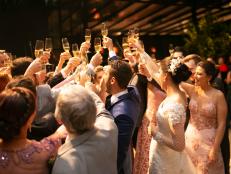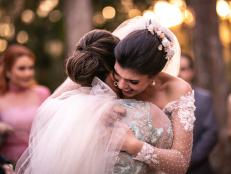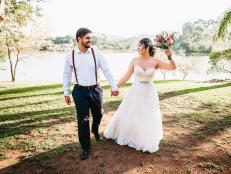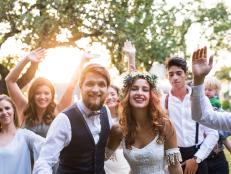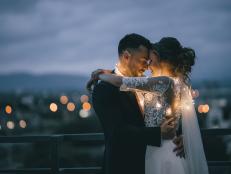10 Ways the Pandemic Changed Weddings Forever
Ceremonies, receptions, venues, and more key wedding details are going to look a little different from now on — here's why.

10 Ways Weddings Have Changed
The pandemic has changed the world in so many ways that nobody saw coming. In 2020, a lot of couples watched as their dreamy wedding plans were paused, canceled, or changed forever. As more and more people gear up to plan their post-pandemic weddings for this year or the next, they are finding themselves wondering how the past year has altered wedding planning and what they should know before they plan their own celebrations.
From guest list size and budget to decor and live streaming, here are the 10 ways the pandemic has changed weddings for years to come.
Say Hello to the Virtual Element
Before the pandemic, weddings and guest lists were simple. You picked your venue, set your guest list, and sent out invitations. Those who could not be there in person relived the joy of the special day through videos and photos afterward.
Many couples are now livestreaming parts of their wedding (whether it’s just the ceremony or both the ceremony and the reception), and they can give more people access to their special day. They can share their best moments with those who can’t travel or have other reasons why they won’t be there in person.
Adding in a virtual element will be more of a standard practice going forward. Couples will think about how much of their wedding they’d like to livestream and how many guests they’d like to host in person.
Couples might even hire an additional vendor that they didn’t consider before: someone to help with the virtual components, like a videographer to assist with the livestream.
Incorporating the Backyard
As venues temporarily shut down, couples who wanted to tie the knot during the pandemic had very limited locations to choose from. A lot of people decided to get married right in their own houses or backyards. While couples used to look for more formal venues for their nuptials (like hotel ballrooms or event spaces), a trend that’s not going away anytime soon is the backyard venue.
Using their own backyards, or borrowing the space from a friend or family member, allows couples to pull off a more intimate and cozy feel for their wedding — all while saving thousands on a special venue.
Multiple Celebrations
With so much uncertainty pausing original wedding plans during the pandemic, many couples opted for multiple celebrations. These included low-key ceremonies (with just a couple of people there in person) and larger parties on a later date.
The idea of separating the ceremony and the reception is something we’ll see a lot more moving forward. Having an intimate ceremony — with a potential option to live-stream to guests who are home — is something that lets the couple have private moment together before celebrating with everyone else on a later date.
Separated Seating Arrangements
Seating arrangements at weddings were always a bit awkward, especially when you were stuck at a table with seven other strangers. Instead of banquet style tables that seat eight to ten people, or longer tables that seat up to 20, smaller tables and the idea of seating people in pods will take the lead — and they’ll change the layout of how the reception is set up.
Grouping people together at smaller tables lets guests stick together with people they know and want to be seated with anyway. Plus, it allows for ongoing social distancing, which isn’t going away anytime soon.
Hiring Vendor Teams
The average couple might hire up to 10 different vendors (from caterers to photographers and videographers). Coordinating with all of them at once is a task that can be exhausting and stressful. When the pandemic altered people’s wedding plans, it also changed their hiring plans. Rather than hiring a handful of individual vendors who have never worked together, couples are looking to hire vendor teams, which might include a wedding planner and that planner’s crew of vendors (photographer, florist, caterer, etc.).
That way, if changes have to be made or if the date of the wedding switched, it is easier to make that happen.
Smaller Budgets
The average wedding, pre-pandemic, cost over $30,000, which is quite a lot of money for a one-day event. But because the pandemic changed the couples’ wedding plans and paused large-scale parties, budgets dropped down to about $19,000 and people realized they could still plan quite a joyous occasion without digging deep into their savings accounts.
Many post-pandemic weddings will have a smaller guest list and more informal decor and venues, keeping the price tag down for years to come.
Mini Guest Lists
The average pre-pandemic guest list was around 150 people. Since a lot of couples had to adjust to the pandemic and choose smaller groups of people to attend, many opted for elopements and mini-mony style occasions that chopped up their guest lists.
Just like the trend of smaller, more private ceremonies with mid-size receptions later on, couples will continue incorporating multiple mini-guest lists into their wedding plans as well.
Perhaps one guest list will just be immediate family for the ceremony and another (around 50-75 people) will work for the future reception. An additional guest list could include people who will only be invited virtually.
Personalization is Prevalent
Incorporating standard wedding traditions, like walking down the aisle or cutting the cake, slipped many couples' minds — and their to-do lists — during the pandemic. Instead of following typical wedding to-do lists, they came up with more unique, personalized ideas for decor, structure, and the overall flow of their big day.
The pandemic helped couples realize what really matters and what just isn’t right for their own weddings. Before, very few people asked questions about having large centerpieces or even wearing a traditional wedding dress, they just did it. Now, people will make their weddings feel more personal and less like the ones they see over and over again on social media.
Practical Party Favors
While the idea of offering guests gifts at the wedding seems like a kind idea, a lot of party favors are often left behind. Rather than waiting until the end of the night to send guests home with a candle, chocolate bar, or monogrammed shot glass, couples are saying yes to more practical party favors from now on.
During the pandemic, couples offered hand sanitizer, face masks, and other essentials at the start of their wedding as practical party favors that people could use while they were there. These usable gifts will cancel out the possibility of party favors being left behind and wasted.
Not One But Two Wedding Outfits
With the rise of couples having separate ceremonies and receptions during the pandemic, a lot of brides opted for not one, but two dresses. Since couples are now seeing the value in splitting up parts of their weddings (ceremony one day and the reception later on), that calls for two separate outfits to wear!
For some, getting a traditional wedding dress is still on their to-do list, but so is finding something a little more casual — and even something that can be worn again for the ceremony.






